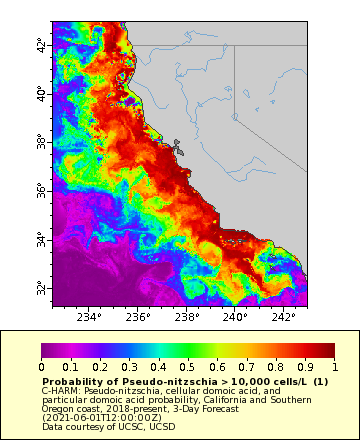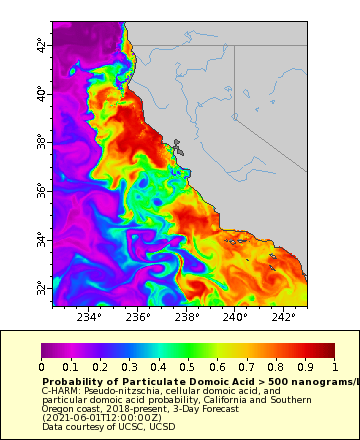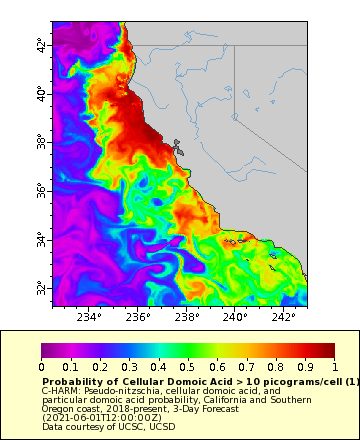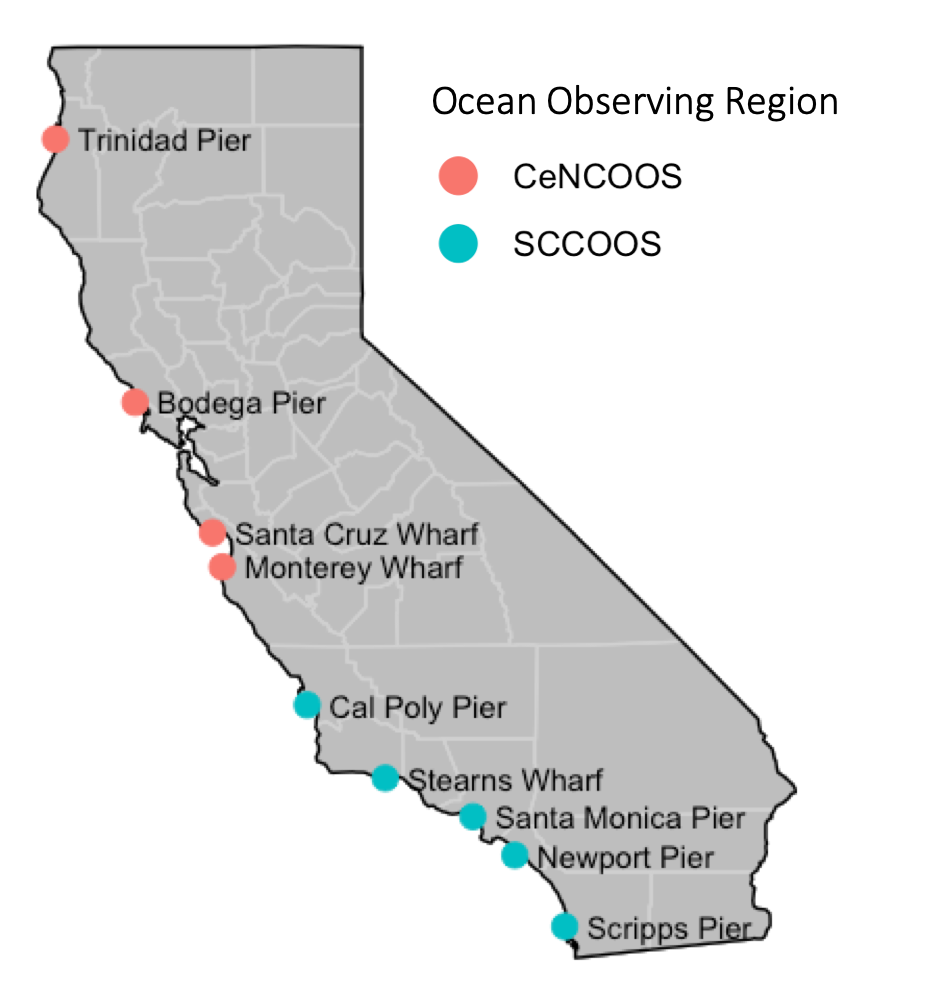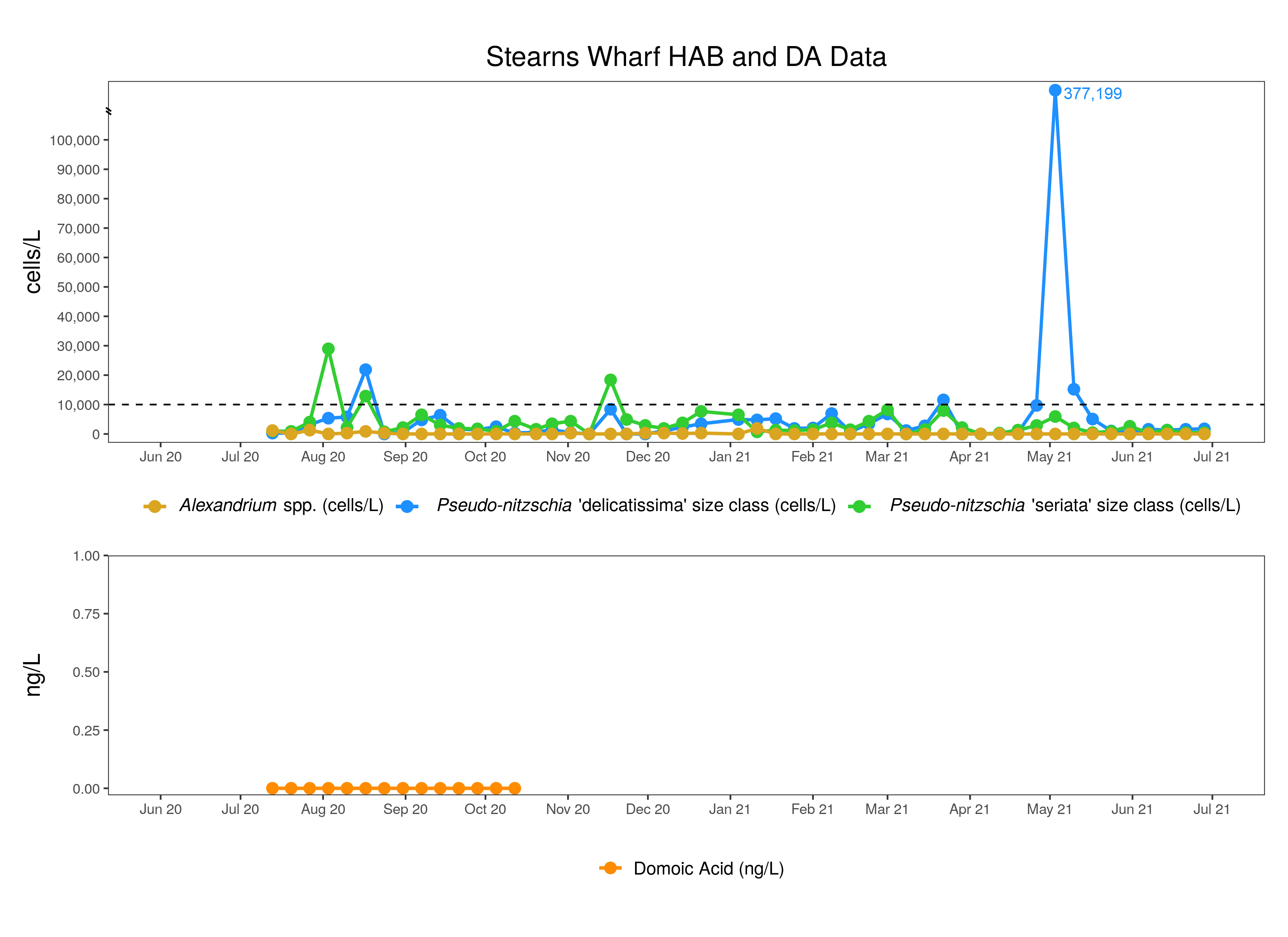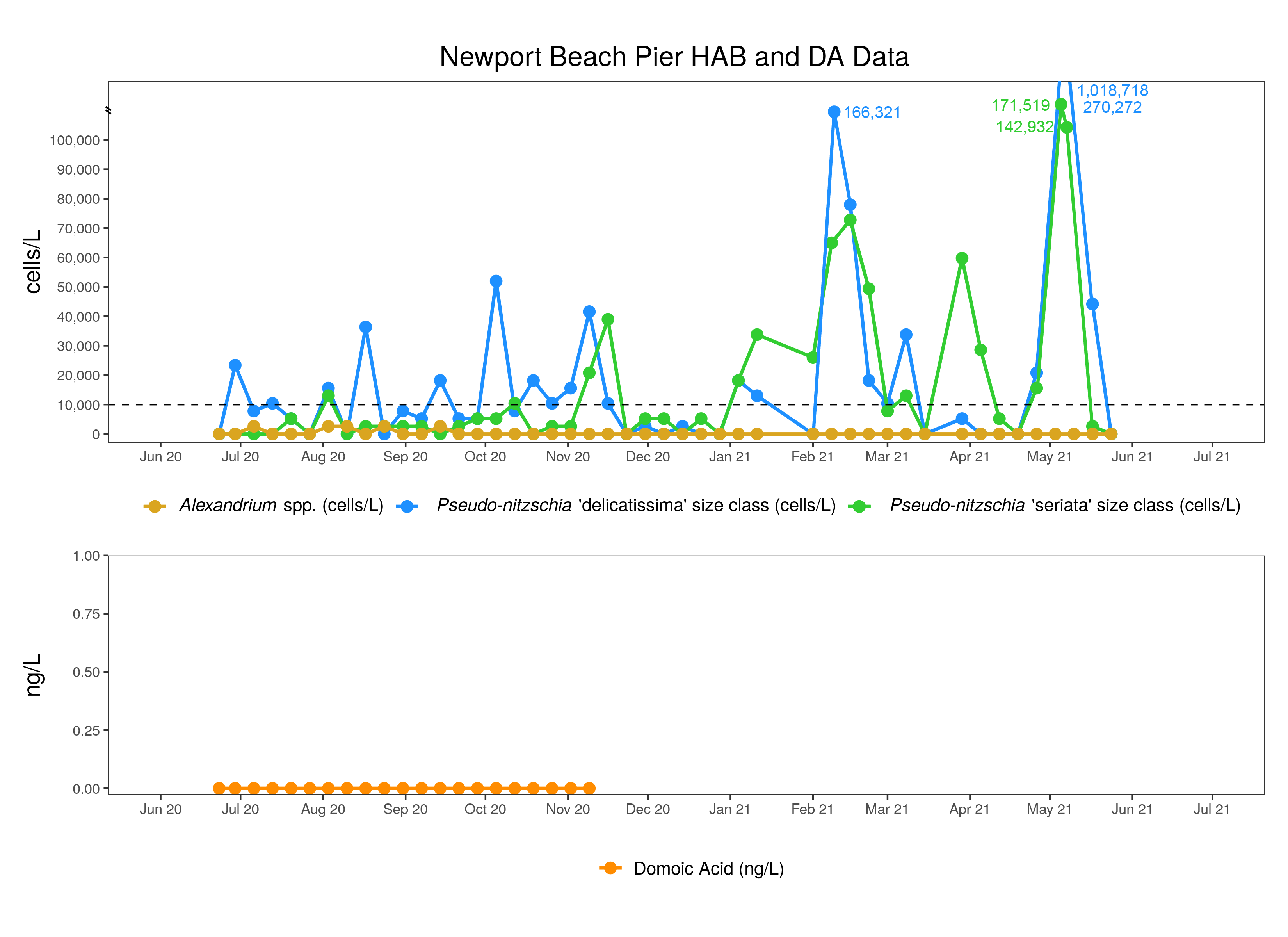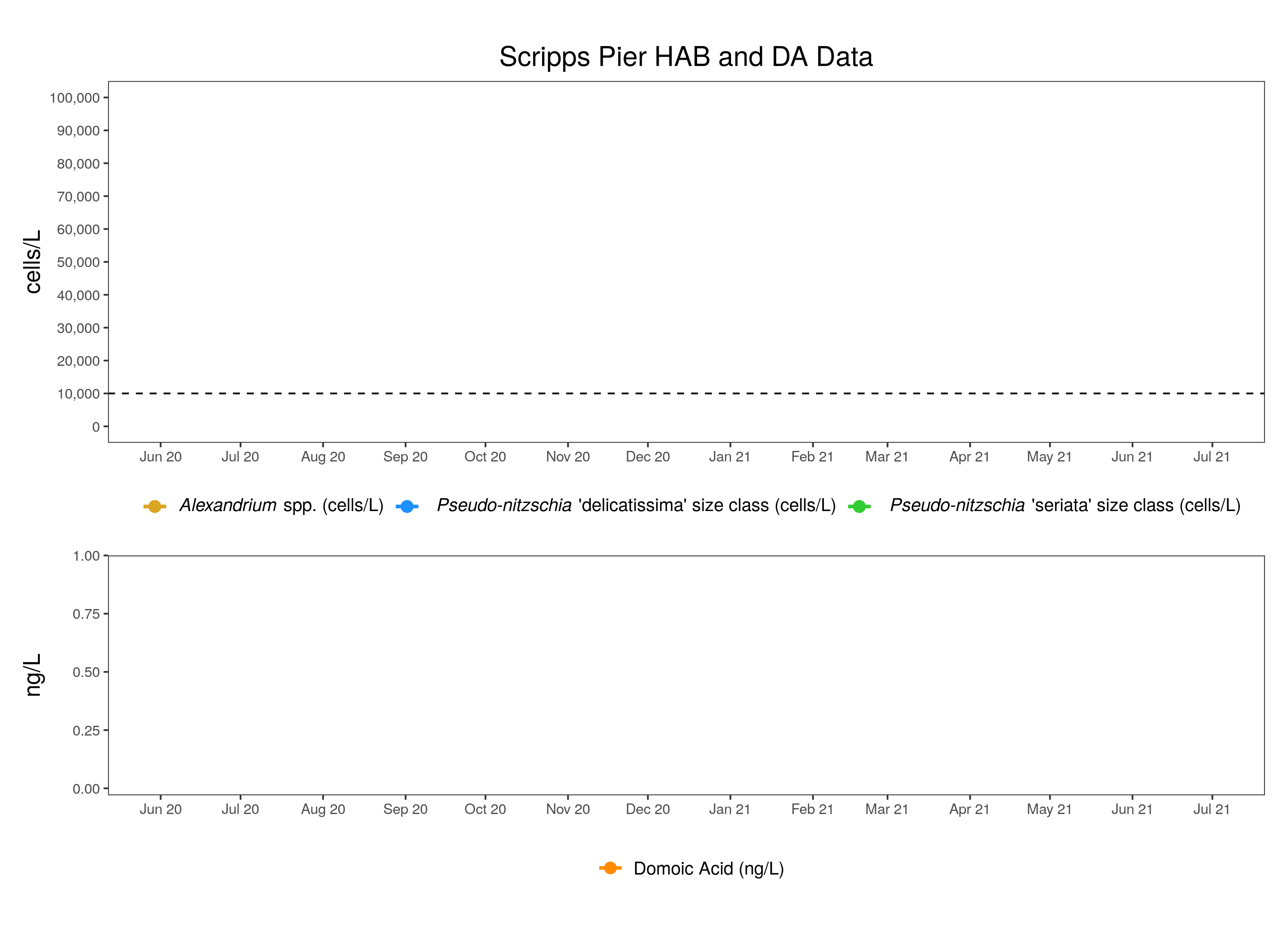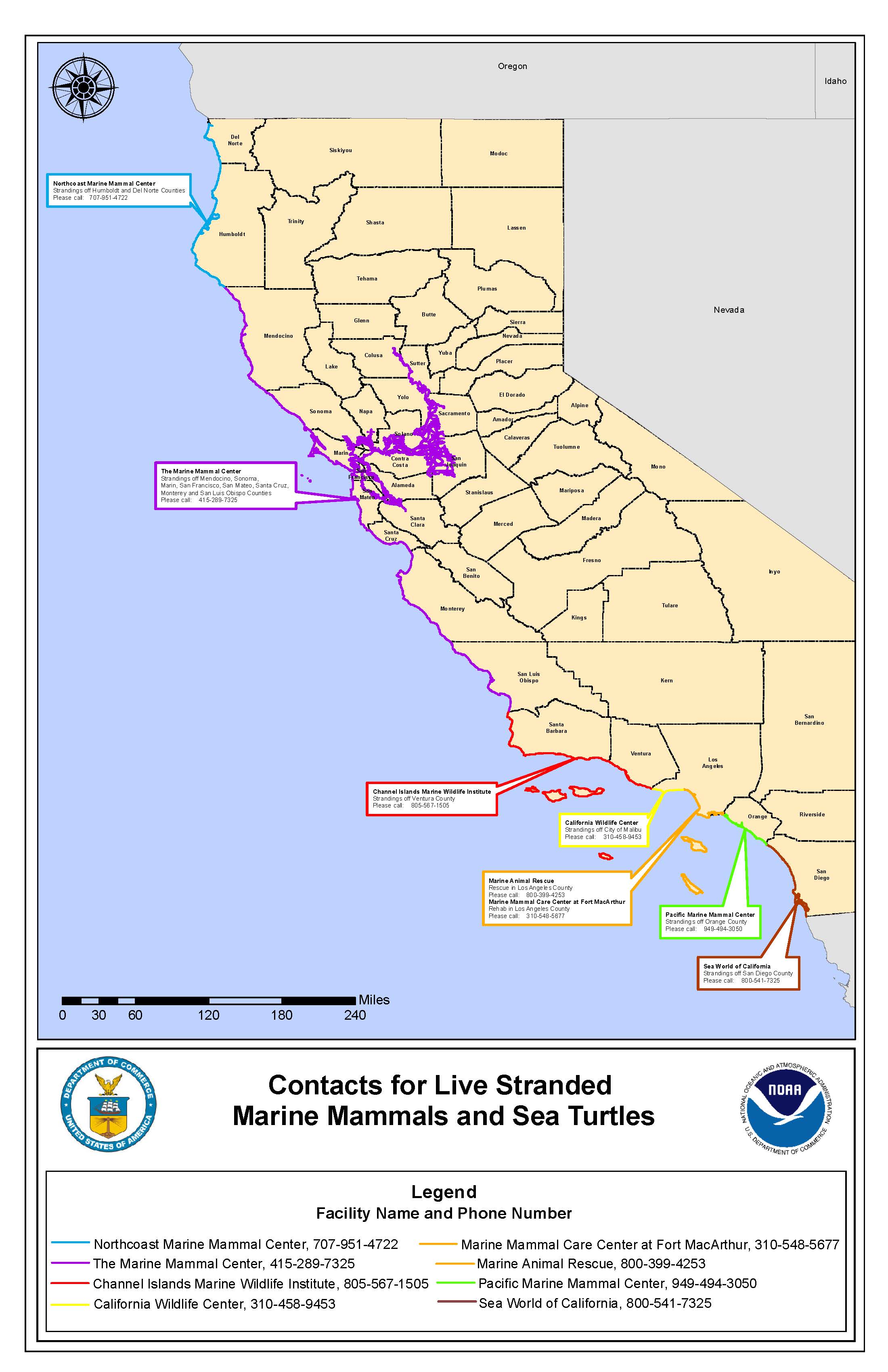Pseudo-nitzschia - C-HARM tells us where conditions are suitable for species of the diatom Pseudo-nitzschia spp. (all size classes) to grow well and where they might be more likely to produce the deadly neurotoxin, domoic acid (DA). C-HARM now routinely predicts suitable habitat for Pseudo-nitzschia spp. throughout the state, suggesting most places are routinely experiencing conditions conducive to growth and blooms throughout the year, with variability from month to month on where the centers of highest likelihood occur. In June, very high bloom probabilities were predicted far offshore for the northern and central coasts of California to the Santa Barbara Channel, while more confined to the nearshore zones of the Southern California Bight where bloom probabilities southeast of the Santa Barbara Channel region were generally low throughout the month. Given ongoing COVID-19 sampling restrictions and delays that continue to hamper our ability to acquire timely HABMAP observations from piers, not all piers are currently providing data. We do know that despite the high probabilities from C-HARM, the only sites with data that were reporting Pseudo-nitzschia in June were Santa Monica Pier, Stearns Wharf, and Cal Poly Pier, the latter capturing near bloom levels of the more toxigenic 'seriata' size class of Pseudo-nitzschia. The less toxigenic P. "delicatissima" well exceeded the bloom threshold at the end of June at Santa Monica Pier. The Relative Abundance Index (RAI) for the Pseudo-nitzschia "seriata" size class recorded by the California Department of Public Health (CDPH) reached moderate or "Common" levels (15-30%) at Diablo Cove (San Luis Obispo region, near Cal Poly Pier), at Mohawk Reef (Santa Barbara Channel), and in the Gulf of Farallones National Marine Sanctuary (northwest of the San Francisco area).
Moderate to very high C-HARM probabilities (50-100%) for particulate domoic acid (pDA) were predicted at different times for several sections of the California coastline in June, but this could easily be called a "central California" event relative to previous months. Zones of high pDA likelihood, or "hotspots," intensified at different times in offshore parts of central CA and parts of coast north of the San Francisco Bay, as well as in and around the Santa Barbara Channel. Similar patterns were predicted for cellular domoic acid (cDA) risk as those for pDA, although with much lower probabilities in the Bight (southeast of the SB Channel) early to mid-month. Those cDA probabilities intensified to near 100% in the Santa Monica/San Pedro Bay area as well as for parts of the Orange County coastline. Relative to April, both pDA and cDA probabilities were intensified for much of the North Coast, which could indicate a real chance of greater toxicity for northern California. HABMAP pDA data are not yet available for June. However, note that the only two California Sea Lion strandings from suspected DA toxicosis in June were reported by The Marine Mammal Center (TMMC) on June 12th in Monterey and June 29th in San Luis Obispo (both in central CA, consistent with the overall trends in C-HARM output). No new shellfish warnings or closures associated with DA occurred in June outside of the annual seasonal quarantine for harvesting recreational shellfish and ongoing razor clam advisories in parts of northern California.
Alexandrium - CDPH noted that Alexandrium spp. were present at Pacifica Pier (near SF) in June, but for the most part, not at significant levels anywhere in the state. This is consistent with HABMAP sampling, which caught increases in Alexandrium numbers twice in June at Cal Poly Pier, 240 miles south of Pacifica. There remain no recreational shellfish advisories related to PSP at this time.
*Please note that HABMAP sampling, CDPH sampling, and marine mammal rescues have been greatly reduced in response to COVID-19 safety measures.
**HABMAP sampling resumed after being suspended in March 2020 in accordance with the Governor's stay at home order. However, COVID-19 safety protocols and sampling restrictions may continue to affect operations and delay results.**
Note that data for some stations are not shown because they are not yet recorded in the public HABMAP archive.
Differentiating Pseudo-nitzschia species by light microscopy is difficult. For this reason, Pseudo-nitzschia "seriata" does not refer to an actual species but rather the larger size class of Pseudo-nitzschia, which is generally a more toxigenic group of species. Alternatively, Pseudo-nitzschia "delicatissima" refers to the smaller size class that is generally non-toxigenic. The dashed line on the plots demarcates the 10,000 cells/L "bloom" threshold designated here for Pseudo-nitzschia populations only.
More information and data visualizations on the statewide HAB network and forecasting system can be found on the California HABMAP website and on the SCCOOS Harmful Algal Bloom page.
Santa Cruz Wharf
Five water samples were collected at Santa Cruz Wharf in June. Molecular probes for toxigenic Pseudo-nitzschia in the "seriata" class are conducted for this site, and was detected on June 16 below threshold. Alexandrium spp. were detected twice (June 9, 16). Domoic acid was not detected.
The Santa Cruz Wharf shore station is supported by CeNCOOS PI Raphael Kudela at UCSC.
Cal Poly Pier
Four water samples were collected at Cal Poly Pier in June. Pseudo-nitzschia "delicatissima" was not detected in any sample. Pseudo-nitzschia "seriata" was detected once (June 14) slightly below the bloom threshold value. Alexandrium spp. were detected twice (June 14, June 21). Domoic acid results are not yet available.
Cal Poly Pier shore station is supported by SCCOOS and PIs Ryan Walter and Ally Pasulka at Cal Poly.
Stearns Wharf
Four water samples were collected at Stearns Wharf in June. Pseudo-nitzschia "delicatissima" and Pseudo-nitzschia "seriata" were detected on each occasion (June 7, 14, 21, 28), all below the bloom threshold. Alexandrium spp. were not detected. Domoic acid results are not yet available.
Stearns Wharf is supported by SCCOOS and PIs Mark Brzezinski and Libe Washburn at UCSB.
Santa Monica Pier
Four water samples were collected at Santa Monica Pier in June. Pseudo-nitzschia "delicatissima" was detected three times (June 14, 21, 28), with only June 28 above the threshold. Pseudo-nitzschia "seriata" was also detected three times (June 14, 21, 28), all below the bloom threshold . Alexandrium spp. were not detected. Domoic acid results are not yet available.
The Santa Monica Pier shore station is supported by SCCOOS and PI Rebecca Shipe at UCLA.
Newport Beach Pier
No water samples were collected at Newport Beach Pier in June.
Newport Beach Pier is supported by SCCOOS and PI David Caron at USC.
Scripps Pier
Scripps Pier water samples are not available for April 2020 through June 2021.
Scripps Pier is supported by SCCOOS and PIs Melissa Carter and Clarissa Anderson at UCSD.
CDPH observations for Pseudo-nitzschia "seriata" and Alexandrium spp.
Please note, starting in July 2019, CDPH moved to only reporting Pseudo-nitzschia of the seriata complex and not all Pseudo-nitzschia spp. as previously provided.
From June 1-30 2021, water samples were collected by volunteers and sent to the California Department of Public Health (CDPH) for analysis. Pseudo-nitzschia "seriata" group was detected in 72 of the 121 samples. Pseudo-nitzschia "seriata" was detected at "Common" density levels (using CDPH relative abundance index) on 6 occasions: June 9 (Goleta Pier, 10% composition), June 15 (GFNMS, Marin Line, 15% composition; Morro Bay boat Launch, 10% composition), June 16 (Goleta Pier, 10% composition; Mohawk Reef, Santa Barbara, 15% composition), June 30 (Diablo Cove, Port San Luis, 30% composition). Pseudo-nitzschia "seriata" was not detected at "Abundant" density levels in June. Alexandrium spp. were detected in 15 of the 121 samples. Alexandrium spp. were detected at "Present" density levels on 1 occasion: June 28 (Pacifica Pier, 2% composition).
You can view an interactive map and data table of CDPH data from January 2019 to present developed by SCCOOS below or you can also view CDPH Toxic Phytoplankton Observations Map with layers of Pseudo-nitzschia and Alexandrium spp. as well as other phytoplankton species observations (in the pop-up windows).
Data are provided by the California Department of Public Health, Environmental Management Branch.
Please email CDPH at Susan.Paulukonis@cdph.ca.gov for any potential marine HAB-related illness in humans.
CDPH and OEHHA Health Advisories
August 11. The California Department of Public Health (CDPH) has lifted the August 2015 shellfish safety notification related to sport-harvested razor clams in Humboldt County.
May 3. The California Department of Public Health (CDPH) has lifted the August 2015 shellfish safety notification related to sport-harvested razor clams in Del Norte County.
April 30. The California Department of Public Health (CDPH) announced the annual quarantine of sport-harvested mussels gathered along the California coast.
For the latest closures and updates, please visit the CDPH Health Advisories page as a central location of information related to CDPH health advisories. Also available is a map showing the current CDPH Recreational Bivalve Shellfish Advisories (see below).
NEWS: The HAB-related illness workgroup has developed a new webpage for marine HAB-related illness tracking work (https://oehha.ca.gov/fish/general-info/marine-harmful-algal-bloom-hab-related-illness-tracking).
Domoic acid (DA) is a potent neurotoxin produced by some diatom species of the genus Pseudo-nitzschia. Species exposed to DA can result in seizures, epilepsy, cardiomyopathy, and death depending upon the ingested dose. DA toxicosis commonly occurs in California Sea Lions (Zalophus californianus), presumably due to a combination of foraging behavior and seasonal movements. The Marine Mammal Center (TMMC), Channel Islands Marine Wildlife Institute (CIMWI), California Wildlife Center (CWC), Marine Mammal Care Center Los Angeles (MMCC-LA), Marine Animal Rescue (MAR), the Pacific Marine Mammal Center (PMMC), and SeaWorld act like an emergency room by working to rescue and rehabilitate sick and injured marine mammals, seabirds, and sea turtles.
Among the six rehabilitation centers we received data for in the month of June, 2 marine mammal strandings presented with symptoms of domoic acid toxicosis.
The CIMWI, CWC, PMMC, MMCCLA did not record any strandings due to suspected domoic acid in June 2021.
June strandings due to suspected DA toxicosis occurred in the following counties:
- Monterey (TMMC)
- June 12 - adult, female, California Sea Lion
- San Luis Obispo (TMMC)
- June 29 - adult, female, California Sea Lion
At this time we do not have data from the North Coast Marine Mammal Center.
Please subscribe to CA HAB Bulletin listserv to receive the monthly CA HAB Bulletin.

